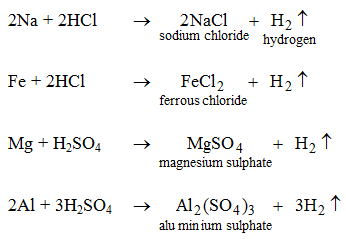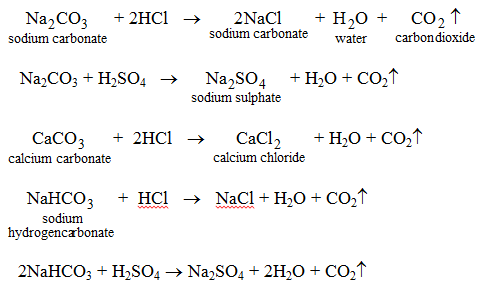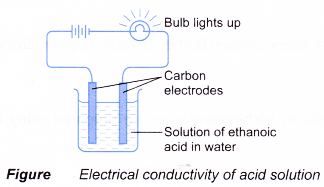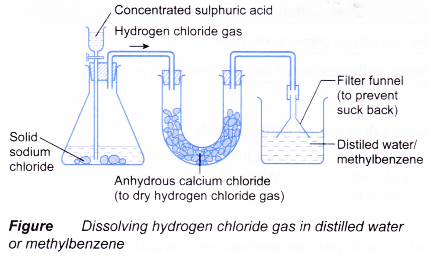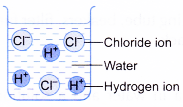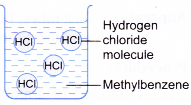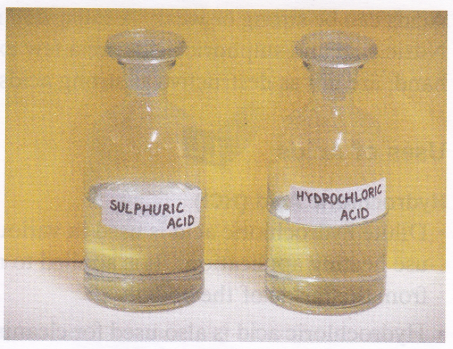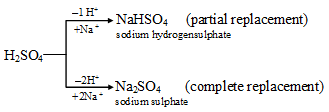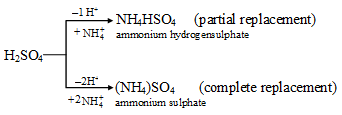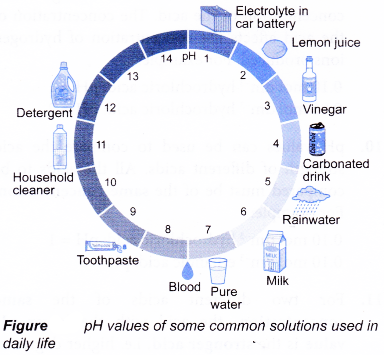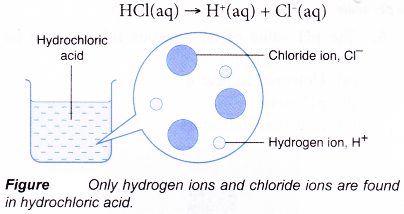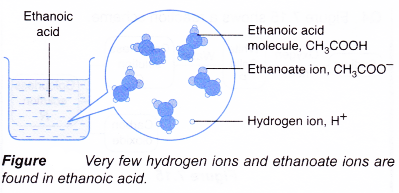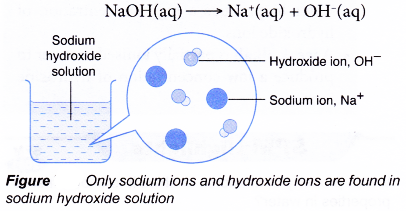New Simplified Chemistry Class 10 ICSE Solutions -A: Acids, Bases and Salts
ICSE SolutionsSelina ICSE SolutionsML Aggarwal Solutions
Viraf J Dalal Chemistry Class 10 Solutions and Answers
Simplified ChemistryEnglishMathsPhysicsChemistryBiology
QUESTIONS
2004
Question 1.
Which of the methods, A, B, C, D or E is generally used for preparing the chlorides listed below from (i) to (v)
(A) Action of an acid on a metal
(B) Action of an acid on an oxide or carbonate
(C) Direct combination
(D) Neutralization of an alkali by an acid
(E) Precipitation (double decomposition)
- Copper (II) chloride
- Iron (II) chloride
- Iron (III) chloride
- Lead (II) chloride
- Sodium chloride Each method is to be used only once.
Answer:
(1) B (2) A (3) C (4) E (5) D
2005
Question 1.
Match from A to F:
A: Acidic oxide,
B: Alkali,
C: Amphoteric oxide,
D: Basic oxide,
E: Deliquescence,
F: Efflorescence
- The property of spontaneously giving up water of crystallization to the atmosphere.
- A compound, soluble in water and the only negative ions in the soln. are hydroxide ions
Answer:
- F: Efflorescence
- B: Alkali
Question 2.
What is observed when, neutral litmus soln. is added to sodium hydrogen carbonate solution.
Answer:

Question 3.
The preparation of lead sulphate from lead carbonate is a two-step process. (Lead sulphate cannot be prepared by adding dilute sulphuric from lead carbonate.)
- What is the first step that is required to prepare lead sulphate from lead carbonate.)
Ans. Treatment with dil. nitric acid to form soluble lead nitrate. - Write the equation for the reaction that will take place when this first step is carried out.
Ans. PbCO3 + 2HNO3 → Pb(NO3)2 + H20 + CO2↑
Insoluble - Why is the direct addition of dil. H2SO4 to PbCO3 an impractical method of preparing lead sulphate.
Ans. Direct addition of dil. sulphuric acid to lead carbonate will lead to deposition of lead sulphate on the surface of lead carbonate which stops further reaction of sulphuric acid on it.
Question 4.
Fill in the blanks:
An acid is a compound which when dissolved in water forms hydronium ions as the only
(1) …. ions. A base is a compound which if soluble in water contains (2)…. ions. A base reacts with an acid to form a (3)…… and water only. This type of reaction is known as (4)…….
Answer:
- Positive
- Hydroxyl
- Salt
- neutralization.
Question 5.
Acid dissolve in water to produce positively charged ions. Draw the structure of these ions
Answer:

Question 6.
Name the ion other than ammonium ion formed when ammonia dissolves in water. Give one test that can be used to detect the presence of the ion product.
Answer:
Hydroxide ion.
2006
Question 1.
Mention the colour changes observed when the following indicators are added to acids:
- Alkaline phenolphthalein solution.
Ans. Pink solution becomes colourless - Methyl orange solution
Ans. Orange solution changes to red or pink - Neutral litmus solution
Ans. It turns red
Question 2.
Which of the following hydroxides is not an alkali – (Choose from the choices A, B, C and D)
(A) ammonium hydroxide
(B) calcium hydroxide
(C) copper hydroxide
(D) sodium hydroxide
2007
Question 1.
Complete the blanks from the list given:
Ammonia, Ammonium, Carbonate, Carbon dioxide, Hydrogen, Hydronium, Hydroxide, Precipitate, Salt, Water. A solution X turns blue litmus red, so it must contain (1) …. ions ; another solution Y turns red litmus blue and therefore, must contain (2)……. ions. When solutions X and Y are mixed together the products will be a (3) …. and (4) If a piece of magnesium were put into solution X, (5)….. gas would be evolved.
Answer:
- hydronium
- hydroxide
- salt
- water
- hydrogen
Question 2.
Match the following:


Answer:
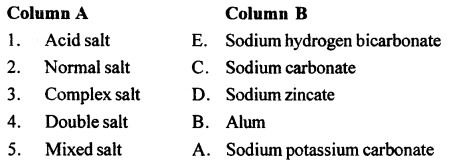
Question 3.
Write balanced equation for formation of PbCl2 from Pb(NO3)2 soln. and NaCl soln.
Answer:
Pb(NO3)2 + 2NaCl → PbCl2 + 2NaNO3
2008
Question 1.
What is the term defined i) A base which is soluble in water.
Answer:
Alkali.
2009
Question 1.
The acid which contains four hydrogen atoms –
(1) Formic acid
(2) Sulphuric acid
(3) Nitric acid
(4) Acetic acid
Question 2.
A black coloured solid which on reaction with dilute sulphuric acid forms a blue coloured solution is:
(A) Carbon
(B) Managanese (IV) oxide
(C) Lead (II) oxide
(D) Copper (II) oxide
Question 3.
Solution A is a strong acid
Solution B is a weak acid
Solution C is a strong alkali
Question 3(1).
Which solution contains solute molecules in addition to water molecules ?
Answer:
Solution B — weak acid
Question 3(2).
Which solution will give a gelatinous white precipitate with zinc sulphate solution? The precipitate disappears when an excess of the solution is added.
Answer:
Solution C — strong alkali
Question 3(3).
Which solution could be a solution of glacial acetic acid ?
Answer:
Solution B — weak acid
Question 3(4).
Give an example of a solution which is a weak alkali.
Answer:
Ammonium hydroxide — weak alkali
Question 4.
Write the equation(s) for the reaction(s) to prepare lead sulphate from lead carbonate.
Answer:

Question 5.
Define the following terms : Neutralization
Answer:
Neutralisation: The reaction in which an acid reacts with a base to form salt and water is known as neutralisation.

2010
Question 1.
A: Nitroso Iron (II) sulphate
B: Iron (III) chloride
C: Chromium sulphate
D: Lead (II) chloride
E: Sodium chloride.
Select from A, B, C, D and E –
- A compound soluble in hot water but insoluble in cold water.
- A compound which in the aqueous solution state,is neutral in nature.
- A deliquescent compound.
Answer:
- Lead (II) chloride
- Sodium chloride
- Iron (II) chloride
Question 2.
Select the correct answer from A, B, C and D –
(1) A weak organic acid is:
A: Formic acid
B: Sulphuric acid
C: Nitric acid
D: Hydrochloric acid
(2) A complex salt is:
A : Zinc sulphate
B : Sodium hydrogen sulphate
C : Iron (II) ammonium sulphate
D : Tetrammine copper (II) sulphate
Question 3.
Give an equation for the conversions
- ZnSO4 to ZnCO3
- ZnCO3 to Zn(NO3)2
Answer:

Question 4.
A: NaOH sol. : B: weak acid C: Dil. H2SO4
Select the one which contains solute ions and molecules.
Answer:
- Solution C
- Solution A
- Solution B
Question 5.
Give balanced equation/s for the preparation of the following salts:
- Copper (II) sulphate from CuO.
- Iron (III) chloride from Fe.
- K2SO4 from KOH sol.
- Lead (II) chloride from PbCO3 (give two equations)
Answer:
(1)

(2)

(3)

(4)

2011
Question 1.
Write the balanced chemical equation: Lead nitrate solution is added to sodium chloride solution
Answer:
Pb (NO3)2 + 2NaCl → PbCl2 + 2NaNO3
Question 2.
Name the method used from the list:
A: Simple displacement
B: Neutralization
C: Decomposition by acid
D: Double decomposition
E: Direct synthesis
For preparation of the following salts –
- Sodium nitrate
- Iron (III) chloride
- Lead chloride
- Zinc sulphate
- Sodium hydrogen sulphate.
Answer:

2012
Question 1.
Match the following:

Answer:
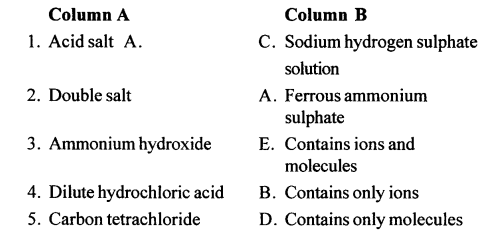
2013
Question 1.
Select the words given below which are required to correctly complete the blanks –
[ammonia, ammonium, carbonate, carbon dioxide, hydrogen, hydronium, hydroxide, precipitate, salt water]:
- A solultion M turns blue litmus red, so it must contain
(1)………..ions ; another solution O turns red litmus blue and hence, must contain, (2)……… ions. - When solution M and O are mixed together, the products will be (3)………. and (4) ……………..
- If a piece of magnesium was put into a solution M,(5)……………..gas would be evolved.
Answer:
(1) hydronium (2) hydroxide (3) salt (4) water (5) hydrogen.
Question 2.
Give a suitable chemical term for:
- A salt formed by incomplete neutralisation of an acid by a base.
- A definite number of water molecules bound to some salts.
Answer:
- Acid salt
- Water of crystallisation
Question 3.
Choosing the substances from the list given:
dil. Sulphuric acid, Copper, Iron, Sodium, Copper (II) carbonate, Sodium carbonate, Sodium chloride, Zinc nitrate
Write balanced equations for the reactions which would be used in the laboratory to obtain the following salts:
- Sodium sulphate
- Zinc carbonate
- Copper (II) sulphate
- Iron (II) sulphate.
Answer:
- Sodium sulphate
Na2CO3 + H2SO4 → Na2SO4 + HzO + CO2
- Zinc carbonate
Zn(NO3)2 + Na2CO3→ ZnCO3 + 2NaNO3 - Copper (II) sulphate
CuCO3 + H2SO4 → CuSO4 + h2o + CO2 - Iron (II) sulphate.
Fe + H2SO4 → FeSO4 + H2
Question 4.
Identify: An acid which is present in vinegar.
Answer:
Acetic acid or ethanoic acid.
2014
Fill in the blank from the choices given:
Question 1.
The basicity of Acetic Acid is 1.
Question 2.
Draw the structure of the stable positive ion formed when an acid dissolves in water.
Answer:

Question 3.
State the inference drawn from the following observations:
Salt S is prepared by reacting dilute sulphuric acid with copper oxide. Identify S.
Answer:
The compound or salt S is copper sulphate CuSO4
CuO + H2 SO4 → CuSO4 + FlO
Question 4.
Give balanced chemical equations to prepareation of the following salts:
- Lead sulphate-from lead carbonate.
- Sodium sulphate-using dilute sulphuric acid.
- Copper chloride-using copper carbonate.
Answer:
(1) Lead sulphate from lead carbonate.
PbCO3 + HNO3 → Pb(NO3)2 + H2O + CO2
Pb(NO3)2 + H2SO4 → PbSO4 + 2HNO3
(2) Sodium sulphate using dilute sulphuric acid.
Na2CO3 + H2SO4(dil) → Na2SO4 + H2O+ CO2
(3) Copper chloride using copper carbonate.
CuCO3 + HCl(dil) → CuCl2 + H2O + CO2
(Insoluble)
2015
Question 1.
Give balanced chemical equations for the following conversions.Fe→ Fed,
Fe →FeCl3
Answer:

Question 2.
From the list of salts — AgCl, MgCl2, NaHSO4, PbCO3, ZnCO3, KNO3, Ca(NO3)2 Choose the salt that most appropriately fits the description given below:
- A deliquescent salt.
- An insoluble chloride.
Answer:
- A deliquescent salt = MgCl2
- An insoluble chloride=AgCl
Question 3.
From the following list of oxides — SO2, SiO2, Al2O3, MgO, CO, Na2O -Select an oxide which dissolves in water forming an acid.
Answer:
SO2
2016
Fill in the blank:
Question 1.
Higher the pH value of a solution, the more………… (acidic / alkaline) it is.
Answer:
Higher the pH value of a solution, the more alkaline it is.
Question 2.
Match the following salts given below:
(1) Pb(NO3)2 from PbO
(2) MgCl2 from Mg
(3) FeCl3 from Fe
(4) NaNO3 from NaOH
(5) ZnCO3 from ZnSO4
With their correct method of preparation from: A, B, C, D and E.
(A) Simple displacement
(B) Titration
(C) Neutralization
(D) Precipitation
(E) Combination
Answer:
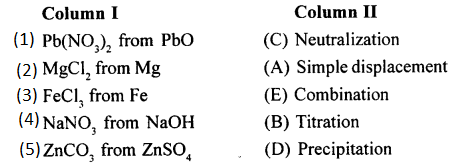
2017
1. Fill in the blanks from the choices given in brackets –
Question 1.
When a metallic oxide is dissolved in water, the solution formed has a high concentration of________ ions. [H+,H3O+, OH ]
Answer:
When a metallic oxide is dissolved in water, the solution formed has a high concentration of OH” ions.
Question 2.
.Choose the correct answer from the options –
(1) to increase the pH value of a neutral solution, we should add: A. An acid; B. An acid salt; C. An alkali; D. A salt,
(2) Anhydrous iron [in] chloride is prepared by:
(A) direct combination;
(B) Simple displacement;
(C) Decomposition;
(D) Neutralization.
Answer:
C. an alkali
Question 3.
Write a balanced chemical equation for the preparation of each of the following salts:
- Copper carbonate,
- Ammonium sulphate crystals.
Answer:
CuSO4(aq) + Na2CO3(uq) → Na2SO4(aq) + CuCO3(s)
2NH4OH(aq) + H2SO4(aq) → (NH4)2SO4 + 2H2O
Additional Questions
Question 1.
Define the following as per ionic theory with examples and ionic equations wherever relevant
(1) acid
(2) base
(3) alkali
(4) neutralization
Answer:
(1) Acid — An acid is a compound which when dissolved in water yields – hydronium ions (H3O+ ) as the only positively charged ion.

(2) Base — A base is a compound which reacts with hydronium ions of an acid – to give salt and water
CuO + 2HCl → CuCl2 + H2O
(3) Alkali — An alkali is a compound which when dissolved in water yields Hydroxyl ions (OH–) as they are negatively charged ions.

Alkali is a base soluble in water.
(4) Neutralization — | H+| ions of an acid completely or combine with |OH+| ions of a base to give salt and water only.
Acid + Base → Salt + Water
HCl + NaOH → NaCl + H2O
Question 2.
Differentiate between:
- Organic and inorganic acids
- Hydracids and oxyacids with examples.
Answer:
(1)
Organic acids – Those acids which are derived from plants, e.g., citric acid, acetic acid, tartaric acid Inorganic acids – Acids derived from minerals e.g. HCl2,h2SO4
(2)
Hydracids – Acids containing hydrogen and a non-metallic element other than oxygen, e.g. HCl, HBr, HI.
Oxyacids – Acids containing hydrogen, another element and oxygen, e.g. HNO3, H,SO4.
Question 3.
State on what basis does the strength of an acid and an alkali depend on.
Answer:
Strength of acids depends upon concentration of hydronium ion |H3O+| present in an aqueous solution
of an acid. Strength of alkali depends on the concentration of the hydroxyl ions |OH–| present in an aqueous solution of an alkali.
Question 4.
Differentiate between (1) strong and weak acid (2) strong and weak alkali with suitable examples and ionic equations.
Answer:
(1) Strong Acid – Is an acid which dissociates – almost completely in aqueous solution there by producing a – high concentration of hydrogen [H+] ions [or H3O+ions]
Examples: Hydrochloric, Sulphuric and Nitric acid.

Weak Acid – Is an acid which dissociates – only partially in a aqueous solution thereby producing a – low concentration of hydrogen [H+] ions [or H3O+ ions].

(2) Strong Alkali – Is an alkali which dissociates – almost completely in aqueous solution thereby producing a – high concentration of hydroxyl [OH–] ions.

Examples: Lithium, Sodium and Potassium hydroxide
Weak alkali – Is an alkali which dissociates – only partially in aqueous solution thereby producing a – low concentration of hydroxyl [OH– ] ions.

Examples: Ammonium hydroxide and Calcium hydroxide.
Question 5.
Name the ions formed when – HCl ; HNO3 ; H2SO4 ; CH3COOH ; NaOH and NH4OH ionise in aq. soln.
Answer:
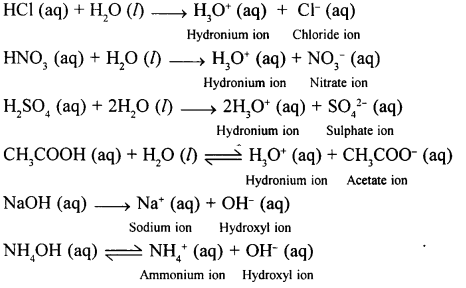
Question 6.
State giving reasons which is a stronger acid – dil. HCl or cone. H2CO3.
Answer:
Dil. HCl is a stronger acid than cone. H2CO3
Reason: HCl ionises almost completely in aqueous solution thereby producing a high concentration of Hp ions in aqueous solution. On the other hand, H2CO3 ionises to a very small extent producing a low
concentration of HO+ ions. More the concentration of H3O+ ions in solution, stronger is the acid. Hence dil. HCl is a stronger acid than cone. H2CO3.
Question 7.
State why the basicity of acetic acid is one and acidity of calcium hydroxide is two.
Answer:
Basicity of an acid is the number of hydrogen ions which can be produced from one molecule of the acids on complete dissociation. Acetic acid, CH.COOH gives one H+ per molecule the acid, hence acetic acid is monobasic i.e., its basicity is one.

Acidity of a base is the number of hydroxyl ions which can be produced from one molecule of the base on complete dissocation. Ca(OH)2 (calcium hydroxide) gives two hydroxyl ions per molecule of the base, hence calcium hydroxide is diacidic i.e., its acidity is two.
Question 8.
Give three reasons with equations wherever required, why sulphuric acid is a dibasic acid.
Answer:
Sulphuric acid (H2SO4) is a dibasic acid as explained below:
(1)
It ionises in aqueous solution to produce two hydrogen ions per molecule of the acid.
OR
It contains two replace all hydrogen ions per molecule of the acid.

(2)
It ionises in two steps in aqueous solution as shown below:

(3)
It forms two types of salt, e., normal salt and acid salt as shown below:

Question 9.
State how acids are defined as per Arrhenius’s and Lowry – Bronsted’s theory.
Answer:
Arrhenius Theory –
Acids are substances which – dissociate in aqueous solution to give H+ ions.
Strong acids dissociate – almost completely, while weak acids dissociate partially.
Question 10.
Oxygen atom in water has two Hone pair of electrons’. Explain the meaning of the term in italics. With the help of an electron dot diagram show the formation of hydronium ion and ammonium ion from a water molecule and an ammonia molecule respectively.
Answer:
A pair of electrons not shared with any other atom for bond formation is called a lone pair of electrons. In water, the central atom – oxygen has two lone pair of electrons as shown ahead:
Structure of water molecule
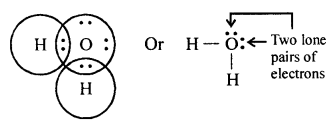
Formation of hydronium ion- (H3O+): When an acid is dissolved in water the proton (H+) released by the acid add onto the lone pair electrons of the oxygen atom of a water molecule. The proton (H+) accepts the lone pair of electrons forming a coordinate bond (shown by an arrow).
HCl → H+ + Cl–
Water Proton Hydronium ion
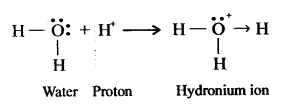
Formation of ammonium ion (NH4+): When ammonia gas is dissolved in water, the proton released by water adds onto the lone pair of electrons of the nitrogen atom of the ammonia molecule. The proton (H+) accepts the lone pair of electrons forming a coordinate bond (shown by an arrow).


Question 11.
State how you would obtain:
- Sulphuric acid from an acidic oxide
- KOH from a basic oxide.
Answer:
(1)

(2)

Question 12.
State two chemical properties each with equations of a solution containing
(1) H+ ions
(2) OH
Answer:
(1) Properties of a solution containing H+ ions: Acids when dissolved in water produce H2O+ or H ions. Typical chemical properties of aqueous solution of acids are:
(a) Neutralisation: H+ ions react with OH ions from alkalies to give water

(b) Reaction with active metals: Active metals like Al, Zn, Fe, etc., react with dil. acids (HCl, H2SO4) to give hydrogen gas. In this reaction H+ is reduced to H, by the active metal. For example,

(2) Properties of solution containing OH– ions: Alkalies when dissolved in water produce OH” ions. Typical reaction of aqueous solution of alkalies are;
(a) Neutralisation: OH+ ions react with H+ ions from acids to give water.

(b) Reaction with solutions of metallic salts: Hydroxides of metals other than Group 1 and 2 are generally insoluble in water. Such hydroxides are precipitated from their respective salt solutions by OH” ions. For example,

Question 13.
Give equations for the decomposition of a metallic
(1) chloride
(2) nitrate with cone. H2SO4.
Answer:
(1) Reaction of cone. H2SO4 with metallic chloride:

(2) Reaction of cone. H2SO4 with metallic nitrate

Question 14.
State in the above reactions a reason for the formation of the respective acids from cone. H2SO4.
Answer:
The reason for the formation of the respective acids from cone. H2SO4 is the volatility of the acid formed. At room temperature or above HCl is a gas while HNO3, which is a liquid at room temperature, volatileses at the reaction temperature (w 200°C).
Question 15.
Convert
(1) NaHCO3
(2) Na2CO3 to unstable carbonic acid by action with dil. H2SO4.
State the reason why ammonia is evolved when an ammonium salt and alkali are heated.
Answer:
- 2NaHCO3 + H2SO4 (dil.) → Na2SO4 + 2H2CO3
- Na2CO3 + H2SO4 (dil.) → Na2SO4 + H2CO3
Ammonia is evolved when an ammonium salt and alkali are heated.

This is because a non-volatile base, Ca(OH)2 displace a volatile base, NH4OH which decomposes to given NH3 and H2O.
Question 16.
Define pH value. What would you say about the pH of a solution in which (i) H+ ions = OH– ions
- evolves CO2when heated with Na2CO3
- OH” ions > H+ ions.
Answer:
pH value: The pH value of a solution is defined as the negative logarithm (to the bsise 10) of the hydrogen ion concentration expressed in mol L-1. Thus,
PH = -log10 [H+]
Where [H+] stands for hydrogen ion concentration in mol L-1.
- A solution in which [H+] = [OH–], is neutral with pH = 7.
- A solution which evolves CO2 with NaCO3 is acidic in nature with pH < 7.
- A solution in which [OH–] > [H+] is basic in nature with pH >7.
Question 17.
State whether litmus is a common acid-base indictor or a universal indicator.
Answer:
Litmus is a common acid-base indicator. It is not a universal indicator.
Question 18.
State the colour change in a neutral litmus in presence of
(1) acidic
(2) alkaline medium.
Answer:
Neutral litmus is purple in colour
- In acidic medium colour of neutral litmus changes from purple to red.
- In alkaline medium colour of neutral litmus changes from purple to blue.
Question 19.
State the colour change in a universal indicator e.g. pH paper on
- slightly acidic soil
- slightly alkaline soil
- dairy milk
- human blood tested for medical diagnosis.
Answer:
- In slightly acidic soil colour of universal indicator changes to yellow.
- In slightly alkaline soil colour of universal indicator changes to blue.
- In dairy milk colour of universal indicator change to green.
- In human blood colour of universal indicator changes to green (pH = 7.3).
Question 20.
Define
(1) salt
(2) normal salt
(3) acid salt – with relevant examples and equations.
Answer:
(1) Salts: A salt is a compound formed by partial or complete replacement of the replaceable hydrogen ions of an acid by a metallic ion or ammonium ion.

(2) Normal salt: The salt formed by complete replacement of the replaceable hydrogen ions present in a molecule of the acid by metallic or ammonium ion. For example,

2NaOH(aq) + H2CO3(aq)→ Na2CO3(aq) + 2H2O (l)
NH4OH(aq) + HCl(aq)→ NH4Cl(aq) + H.O (l)
(3) Acid salt: The salt formed by partial replacement of the replaceable hydrogen ions present in a molecule of the acid by metallic or ammonium ion. For example,
NaOH(aq) + H3PO4(aq) → NaH2PO4(aq) + H2O(l)
2NaOH(aq) + H3PO4(aq)→Na2HPO4(aq) + 2H2O (l)
KOH(aq) + H2SO4(aq)→ KHS04(aq) + H2O(l)
NH4OH(aq) + H2CO3(aq)→NH4HCO3(aq) + H.O (l)
Question 21.
State:
- the formation
- the components of – a basic salt.
State which of following salts is an – acid, normal or basic salt.
- bleaching powder
- potassium mercuric iodide
- sodium sulphite
- sodium hydrogen sulphite
- sodium silver cyanide
- basic lead nitrate
- potassium zincate
- alum
- calcium bicarbonate
- basic copper chloride
- trisodium phosphate.
Answer:
(1) Formation of a basic salt: A basic salt is formed by partial replacement of hydroxyl group of a diacidic or triacidic base with an acid radical (or an anion other than OH).
(2) Components of a basic salt: A basic salt contains a cation (other than H+ ion), a hydroxyl ion (OH– from base) and an anion (other than OH– ion). For example,

- Bleaching powder, CaOCl, (Normal salt/Mixed salt)
- Potassium mercuric iodide, K2(HgI4) .
(Normal salt/Complex salt) - Sodium sulphate, Na2SO4 (Normal salt)
- Sodium hydrogen sulphite, NaHSO3 (Acid salt)
- Sodium silver cyanide, Na[Ag(CN)2]
(Normal salt/Complex salt) - Basic lead nitrate, Pb(OH)NO3 (Basic salt)
- Potassium zincate, K2ZnO2 (Normal salt)
- Alum or potash alum, K2SO4.Al2(SO4)3.24H2O
(Normal salt/Double salt) - Calcium bicarbonate, Ca(HCO3)2 (Acid salt)
- Basic copper chloride, Cu(OH)Cl (Basic salt)
- Trisodium phosphate, Na3PO4 (Normal salt)
Question 22.
Name three (1) sulphates (2) chlorides insoluble in water and – two (1) oxides (2) carbonates soluble in water.
Answer:
(1) Three sulphates insoluble in water
Lead sulphate (PbSO4), Calcium sulphate (CaSO4), and Barium sulphate (BaSO4).
(2) Three chloride insoluble in water
Silver chloride (AgCl), Lead chloride (PbCl2), and Mercury chloride (Hg2Cl2 or HgCl).
(1) Two oxides soluble in water
Sodium oxide (Na2O ), and Potassium oxide (K2O)
(2) Two carbonates soluble in water
Sodium carbonate (Na2CO3), and Ammonium carbonate [(Na4)2CO3]
Question 23.
State the method only, generally used for the preparation of the following salts
(1) Zn(NO3)2
(2) NH4Cl
(3) ZnSO4
(4) ZnS
(5) CaCO3
(6) FeCl3
(7) PbCl2
(8) Pb(NO3)2–
Answer:
| Salt | Method of preparation |
| 1. Zn(NO3)2 | Neutralisation of insoluble base by acid/Decomposition of insoluble carbonate by acid |
| 2. NH4Cl | Neutralisation (titration) of soluble base by acid/Decomposition of soluble carbonate by acid |
| 3. ZnSO4 | Neutralisation of insoluble base by acid/Decomposition of insoluble carbonate by acid |
| 4. ZnS | Direct combination (Synthesis)/Double decomposition (Precipitation) |
| 5. CaCO3 | Double decomposition (Precipitation) |
| 6. Fecl3 | Direct combination (Synthesis)/ |
| 7. pbCl2 | Double decomposition (Precipitation) |
| 8. Pb(NO3)2 | Neutralisation of insoluble base by acid/Decompostion of insoluble carbonate by acids |
Question 24.
Give balanced equations for the preparation of the following salts –
(a)
(1) CuSO4
(2) NaHSO4
(3) Na2SO4
(4) FeSO4
(5) BaSO4
(6) PbSO4 – using dil. H2SO4
(b)
(1) NaHSO4
(2) CuSO4 – using cone. H2SO4.
Answer:
(a) Using dil. H2SO4
- CuO (s) + H2SO4 (aq) → CuSO4 (aq) + 2H2O (l)
- NaOH (aq) + H2SO4 (aq) → NaHSO4 (aq) + H2O(l)
- 2NaOH (aq) + H2SO4 (aq)→Na2SO4 (aq) + 2H2O(l)
- Fe (s) + H2SO4 (aq)→ FeSO4 (aq) + H2 (g)
- BaCl2 (aq) + H2SO4 (aq)→ BaSO4 (s) + 2HCl (aq)
- Pb(NO3)2 + H2SO4 (aq)→ PbSO4 (s) + 2HNO3 (aq)
(b) Using cone. H2SO4

Question 25.
Starting from insoluble ZnO how would you obtain insoluble ZnCO3 by precipitation.
Answer:
ZnO (s) + 2HCl (aq)→ ZnCl2 (aq) + H2O(l)
ZnCl2 (aq) + Na2CO3 (aq)→ ZnCO3 (s) + 2NaCl (aq)
Dissolve zinc oxide in minimum quantity of dil. HCl. Add to it a saturated solution ofNa2CO3 in water till
no more precipitation takes place. Filter and dry the ZnCO3 so obtained.
Question 26.
Give balanced equations for the action of a dilute acid on
(1) zinc carbonate,
(2) potassium bicarbonate for the preparation of the respective salt.
Answer:
- Zinc carbonate
ZnCO3 + 2HNO3 → Zn(NO3)2 + H2O + CO
- Potassium bicarbonate
2KHCO3 + H2SO4 → K2S04 + 2H2O + 2CO2
Question 27.
Give balanced equations for the decomposition of
(1) calcium bicarbonate by dil. HCl,
(2) calcium carbonate by dil. HNO3,
(3) sodium sulphite by dil. H2SO4,
(4) zinc sulphide by dil. H2SO4.
Answer:
- Ca(HCO3)2 + 2HCl→ CaCl2 + 2H2O+ 2CO2
- CaCO3 + 2HNO3 → Ca(NO.)2 + H2O+ CO2
- Na2SO3 + H2SO4 (dil.) → Na2SO4 + H2O+ SO2
- ZnS + H2SO4 →ZnSO4 + H2S
Question 28.
State what will be the effect of each of the following solution on blue litmus –
(1) K2CO3 soln
(2) KCl soln.
(3) NH4NO3
Answer:
- K2CO3 is a salt of a strong base (KOH) and weak acid (H2CO3). Hence its aqueous solution will be basic in nature. It will have no effect on blue litmus solution.
- KCl is a salt of a strong acid (HCl) and a strong base (KOH). Hence its aqueous solution will be neutral in nature. It will have no effect on blue litmus solution.
- NH4NO3 is a salt of a strong acid (HNO3) and weak base (NH4OH). Hence its aqueous solution will be acidic in nature. It will turn blue litmus solution red.
Question 29.
Select the correct acid, base or salt from the list in bracket for each of the statements given below:
- An example of an acid derived from a mineral is……….. (citric acid / nitric acid / acetic acid)
Ans. Nitric acid
- An example of a base which is not a alkali is….. (caustic soda / zinc hydroxide / liquor ammonia / caustic potash)
Ans. Zinc hydroxide
- An example of a strong acid is dilute……… (acetic acid / sulphuric acid / tartaric acid / carbonic acid)
Ans. Sulphuric acid
- An example of a weak alkali is…. (potassium hydroxide / calcium hydroxide / sodium hydroxide) solution.
Ans. Calcium Hydroxide
- An acid having basicity 1 is……… (carbonic acid / acetic acid / sulphurous acid)
Ans. Acetic acid
- An acid obtained by dissolving sulphur trioxide in water is…. (sulphurous acid / sulphuric acid oleum)
Ans. Sulphuric acid
- A volatile acid obtained when nitre reacts with nonvolatile concentrated sulphuric acid on heating is (hydrochloric acid / sulphuric acid/ nitric acid)
Ans. Nitric acid
- A base obtained when lead nitrate undergoes thermal decomposition is……. (trilead tetroxide / lead (IV) oxide/ lead (II) oxide. .
Ans. Lead (II) oxide
- An acid obtained when concentrated nitric acid is heated with sulphur is…….. (sulphurous acid / sulphuric acid / nitrous acid)
Ans. Sulphuric acid
- The more volatile acid obtained when the less volatile acid reacts with sodium bicarbonate is……… (sulphuric acid / carbonic acid / nitric acid)
Ans. Carbonic acid
- The insoluble base obtained when sodium hydroxide reacts with iron (III) chloride is…. (iron (II) hydroxide / iron (III) hydroxide / iron (II) oxide)
Ans. Iron (III) hydroxide.
- A solution whose pH is above 7 is….. (vinegar / milk / liquor ammonia.
Ans. Liquor Ammonia
- The salt formed when sulphuric acid reacts with excess caustic soda solution is…… (sodium bisulphite / sodium sulphate / sodium sulphite / sodium bisulphate).
Ans. Sodium sulphate
- An example of an acid salt is……. [CH3COONa/NaNO3/ Na2HPO4/NaKCO3]
Ans. Na2HPO4
- An example of a soluble salt is ……… (AgCl / PbSO4 /CaSO4 / CaCl2)
Ans. CaCl2
- An example of an insoluble salt is….. (Na2CO3 \ K2CCl,/ MgCO3 / (NH4)2 CO3)
Ans. MgCO3
- A salt prepared by neutralization in which titration is involved is…….. (MgCl2 / CaCl2 / NH,Cl / CuCl2)
Ans. NH4Cl - An insoluble salt prepared by direct combination or synthesis is……. [FeCl3 / FeSO4 / FeS/Fe(NO3)2] Ans. FeS
- A salt prepared by precipitation i.e. by double decomposition of two salt solutions is………… (Na2SO4 /PbSO4 / ZnSO4 / CuSO4)
Ans. PbSO. - A salt prepared by simple displacement i.e. action of dilute acid on a metal is____ (PbCl2/ CuCL, / AlCl3 / HgCl)
Ans. AlCl3 - Decomposition of calcium hydrogen carbonate with…. [dil. HNO3 /dil. HCl/dil. H2SO4] results in formation of calcium chloride.
Ans. dil.HCl
- Action of dilute acid on a metallic sulphide results in evolution of____ [SO2/H2S/CO2] gas.
Ans. H2S
- A salt which on hydrolysis produces a neutral solution is……. (sodium chloride / ammonium chloride / sodium carbonate)
Ans. Sodium chloride
Unit test Paper 3 A —Acids, Bases and Salts
l. Name the following:
- A basic solution which does not contain a metallic element.
Ans. Ammonium Hydroxide.
- A normal salt of sodium formed from acetic acid.
Ans. Sodium acetate, COCOON a. - A base which reacts with an acid to give a salt which .on hydrolysis gives a slightly acidic solution.
Ans. Ammonium hydroxide (NH4OH)
OR
Calcium hydroxide [Ca(OH)2].
- An ion which combines with a polar covalent molecule to form an ammonium ion.
Ans. Hydrogen ion a proton (H+).
- A soluble salt formed by direct combination between a light metal & a greenish yellow gas.
Ans. AlCl3
2. Identify which of the following terms matches with the appropriate description 1 to 5.
A: Hydracid
B: Monobasic acid
C: Less volatile acid
D: Weak acid
E: Tribasic acid
F: Dibasic acid
G: More volatile acid
- An acid having basicity 1 and having only one replaceable hydrogen ion per molecule of the acid.
Ans. Monobasic acid
- An acid which dissociates to give a low concentration of H+
Ans. Weak acid
- An acid containing hydrogen and a non-metallic element other than oxygen.
Ans. Hydracids.
- The type of acid which generally displaces another acid when the acid is heated with a salt.
Ans. Less volatile acid
- The type of acid which reacts with a base to give an acid salt and a normal salt.
Ans. Dibasic acid
3. State which of the following methods is generally used for preparing the salts 1 to 5 given below:
A: Neutralisation – insoluble base and dil. acid
B: Neutralisation – alkali and dil. acid
C: Simple displacement – active metal and dil. acid
D: Direct combination
E: Precipitation (double decomposition) .
- PbCO3
- Zn(NO3)2
- NaCl
- Cu(NO3)2
- FeS
Answer:
- PbCIO3: Precipitation (Double decomposition) (E)
- Zn(NO3)2: Simple displacement-active metal and dil. acid (C)
- NaCl: Neutralisation-alkali and dil. acid (B)
- (CuNO3)2: Neutralisation + insoluble base and dil. acid (A)
- FeS: Direct combination (D)
4. Give balanced equations for the preparation of the following salts:
- Calcium oxide → Calcium chloride → Calcium carbonate
Ans. CaO + 2HCl → CaCl2 + H2O - Zinc sulphide Zn→ Zinc sulphate
Ans. Zn + S → ZnS - Iron (II) chloride ← Fe→ Iron (III) chloride
Ans. Fe + 2HCl → FeCl2 + H2 - Lead (II) oxide → Lead nitrate→ Lead sulphate
Ans. PbO + 2HNO3 → Pb(NO3)2 + H2O - Copper (II) oxide → Copper (II) sulphate ←Copper (II)hydroxide
Ans. CuO + H2SC4 → CuSO4+ H2O
5. The diagram represents the preparation of sodium sulphate salt from dil. H2SO4 acid and sodium hydroxide.

- Name the apparatus ‘A’.
Ans. Burette
- Name the substance ‘X’ placed in ‘A’ and the (substance ‘Y’ placed in B.
Ans. Dil. H2SO4 Sodium Hydroxide
- State the reason for conducting the titration using the apparatus ‘A’ and ‘B’
Ans. Titration is conducted to determine the completion of the neutralisation reaction, i.e. to determine the amount of sulphuric acid required to neutralise a known amount of sodium hydroxide.
- State which solution is transferred to the evaporating dish and evaporated to point of crystallisation for obtaining the salt.
Ans. Sodium Sulphate.
- State why titration is not conducted for the preparation of copper (II) sulphate crystals by neutralisation.
Ans. This is because copper (II) oxide is not soluble in water.
6. Give reasons for the following:
Question 6(1).
Concentrated sulphuric acid is a weaker acid compared to dilute sulphuric acid.
Answer:
Sulphuric acid,H2SO4 is a covalent compound as shown below.

When dissolved in water, polar water molecules helps in its ionisation, thus producing B,O+ ions responsible for its acidic nature. More water (i.e., dilute acid) means more H3O+ ions and hence stronger acid.
Question 6(2).
An aqueous solution of the salt ammonium chloride is acidic in nature while an aqueous solution of sodium chloride is neutral.
Answer:


From above equation it is clear that NH4Cl forms weak alkali which is acidic in nature where as NaCl from strong alkali which is neutral.
Question 6(3).
In the preparation of an insoluble salt from another insoluble salt by precipitation [double decomposition], dilute nitric acid and not dilute sulphuric acid is generally used.
Answer:
Direct addition of dil. H2SO4 to PbCO3 is an impractical method of preparing lead sulphate since PbSO4 is insoluble and forms a coating on PbCO3, thereby the reaction slowly comes to a stop.
Question 6(4).
Acetic acid does not form an acid salt but forms a normal salt.
Answer:
Acetic acid (CH3COOH) is a monobasic acid, i.e. it contains only one replaceable hydrogen ion per molecule of the acid. As such it can only form normal salts.
Question 6(5).
Sulphurous acid forms two types of salts on reaction with an alkali.
Answer:
Sulphurous acid (H2SO3) is a dibasic acid, i.e., it contains two replaceable hydrogen ions per molecule. As such, it can form normal salt (say Na2SO3) as well as acid salt (NaHSO3) on reaction with an alkali.
For More Resources
